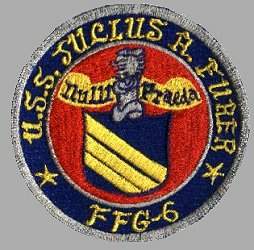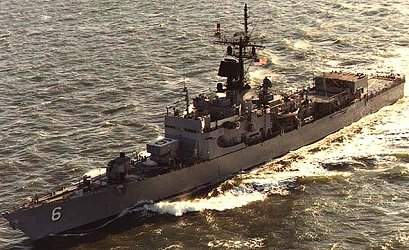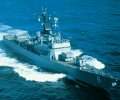

 |
Search the Site with

|
 |  |
USS JULIUS A. FURER was the 6th and final BROOKE - class guided missile frigate and the first ship in the Navy to bear the name. Decommissioned on January 31, 1989, JULIUS A. FURER was leased to Pakistan the same day where she was renamed BADR.
The ship was given back to the US Navy on December 11, 1993 in Singapore and on March 29, 1994, was sold for scrap to Trusha Investments Pte. Ltd., c/o Jacques Peirot, Jr. & Sons, of New York City for $660,600.
| General Characteristics: | Awarded: May 24, 1963 |
| Keel Laid: July 12, 1965 | |
| Launched: July 22, 1966 | |
| Commissioned: November 11, 1967 | |
| Decommissioned: January 31, 1989 | |
| Builder: Bath Iron Works, Bath, Maine | |
| Propulsion system: 2 Foster Wheeler 1,200 psi boilers, 1 GE steam turbine, 1 shaft, 35,000 total horsepower | |
| Propellers: one | |
| Length: 414,4 feet (126.3 meters) | |
| Beam: 45 feet (13.5 meters) | |
| Draft: 26 feet (7.9 meters) | |
| Displacement: 3,425 tons | |
| Speed: 27 knots | |
| Aircraft: one | |
| Armament: one Mk 22 Mod. 0 guided missile launcher for 16 Standard SM-1 MR, one Mk 30 5-inch/12.7cm gun, MK 32 ASW torpedo tubes (two triple mounts), one Mk 16 ASROC missile launcher | |
| Crew: 17 Officers, 219 Enlisted |
Crew List:
This section contains the names of sailors who served aboard USS JULIUS A. FURER. It is no official listing but contains the names of sailors who submitted their information.
USS JULIUS A. FURER Cruise Books:
About the Ship's Name:
Julius Augustus Furer, naval constructor, inventor, administrator, and author, was born 9 October 1880 at Mosel, Wis. Appointed to the Naval Academy in 1897, he graduated at the head of his class in 1901. After sea duty in INDIANA (BB 1) and torpedo boat SHUBRICK, he acquired a Master of Science degree from the Massachusetts Institute of Technology in 1905.
In the era of great naval expansion after the Spanish-American War, Furer established a reputation for professional competence in his remarkably expeditious outfitting of the Navy Base at Charleston, S.C., which at that time lacked a physical plant, natural resources, and a skilled shipbuilding labor force.
While serving in the Philadelphia Navy Yard in 1911, he applied new theories of scientific management. His advanced thinking and methods of procurement brought him the added task of purchasing all tools, machinery, and dock facilities for the Navyís new base for the Pacific Fleet: Pearl Harbor. Furer installed the equipment in 18 months, but delayed his departure when submarine F-4 (SS 23) sank in 50 fathoms off Honolulu. He insisted on salvaging her, and invented a submersible pontoon which raised the boat and enabled her to be moved to drydock. An investigation of her hull revealed a design error which was corrected to avoid similar accidents.
Furer returned to Washington late in 1915 and took charge of the Supply Division, Bureau of Construction and Repair. Against some opposition by advocates of smaller vessels, he proposed the construction of 110-foot submarine chasers to meet the threat of the German U-boat. Furerís arguments persuaded the Navyís General Board to order 450 vessels constructed on Furerís basic design. These contributions to the American war effort earned Furer the Navy Cross.
Following the war, he reported to the staff of the Commander in Chief, Pacific Fleet, and tirelessly devoted his talent to the improvement of damage control, ship design, and crew comfort. From December 1922 to April 1927, he was a member of the U.S. Naval Mission to Brazil.
Furer next was assigned to the Asiatic Station, where he developed extensively the aircraft facilities at Cavite, Philippine Islands.
In 1928, he became Manager of the Industrial Department of the Philadelphia Navy Yard, and supervised the modernization of battleships PENNSYLVANIA (BB 38) and NEW MEXICO (BB 40). Under his management, the yard set records for low costs and speed of construction.
Between July 1935 and December 1937, Furer was Naval Attache at embassies in London, Paris, Berlin, and Rome. His technical advice aided the American delegation to the London Naval Conference in 1936.
A Rear Admiral at the outbreak of World War II, he became the Coordinator of Research and Development, and the senior member of the National Research and Development Board. He coordinated widespread research that speeded development of modern weapons systems for the Navy. These services won Furer the Legion of Merit 30 June 1945.
Julius Furer retired from active service in 1945, but was recalled to duty in the Navyís History Division in 1951. During a second retirement, he wrote the widely acclaimed study, "Administration of the Navy Department in World War II", published in 1960.
Rear Admiral Julius A. Furer died 6 June 1963 and is buried at Arlington National Cemetery.
USS JULIUS A. FURER Image Gallery:
 |
 Back to Frigates list.
Back to Frigates list.  Back to ships list.
Back to ships list.  Back to selection page.
Back to selection page.  Back to 1st page.
Back to 1st page.